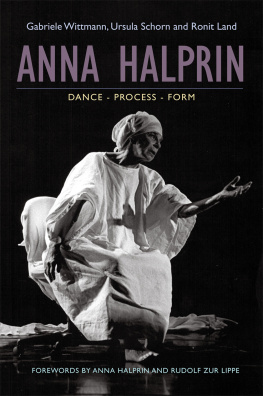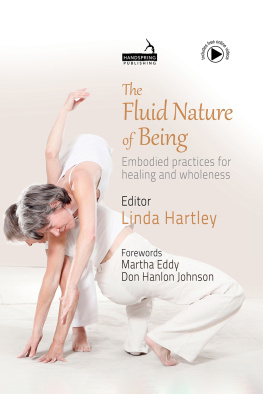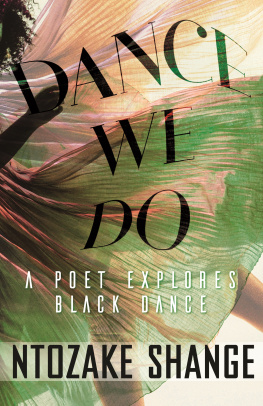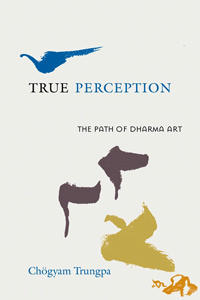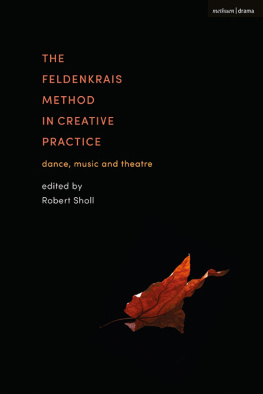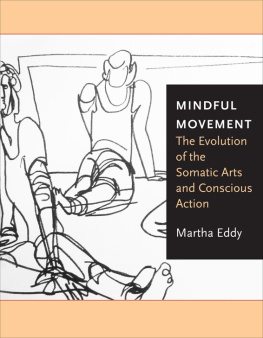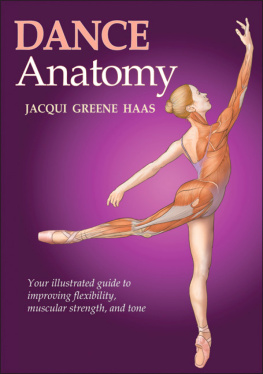
Anna Halprin
of related interest
The Expressive Body in Life, Art, and Therapy
Working with Movement, Metaphor and Meaning
Daria Halprin
Foreword by Jack S. Weller
ISBN 978 1 84310 737 8
eISBN 978 1 84642 375 8
Soul and Spirit in Dance Movement Psychotherapy
A Transpersonal Approach
Jill Hayes
Foreword by Daria Halprin
ISBN 978 1 84905 308 2
eISBN 978 0 85700 649 3
Presence and Process in Expressive Arts Work
At the Edge of Wonder
Herbert Eberhart and Sally Atkins
Foreword by Paolo Knill
ISBN 978 1 84905 957 2
eISBN 978 0 85700 811 4
Authentic Movement
Essays by Mary Starks Whitehouse, Janet Adler and Joan Chodorow
Edited by Patrizia Pallaro
ISBN 978 1 85302 653 9
eISBN 978 1 84642 992 7
Authentic Movement: Moving the Body, Moving the Self, Being Moved
A Collection of Essays Volume Two
Edited by Patrizia Pallaro
ISBN 978 1 84310 768 2
eISBN 978 1 84642 586 8
Anna Halprin
DANCE PROCESS FORM
Gabriele Wittmann,
Ursula Schorn and Ronit Land
Forewords by Anna Halprin and Rudolf zur Lippe
Translated by Anne Oppenheimer

Jessica Kingsley Publishers
London and Philadelphia
Photographs and paintings provided with kind permission. 4: Olve Alstrom. 5: Paul Ryan. 6: Coni Beeson. 7: Paul Ryan. 8: Ruedi Bender. 9: Peter Larsen. 12: Ursula Schorn. 13: Marguerite Lorimer. 14: Coni Beeson. 16: Jon Kokoska. 17: Susanne Schnieder. 18: Susanne Schnieder. It has not been possible to trace the photographers not listed.
This translation of Anna Halprin: Tanz Prozesse Gestalten is published by arrangement with K. Kieser Verlag, 81541 Mnchen, Germany.
English language edition first published in 2015
by Jessica Kingsley Publishers
73 Collier Street
London N1 9BE, UK
and
400 Market Street, Suite 400
Philadelphia, PA 19106, USA
www.jkp.com
Copyright Gabriele Wittmann, Ursula Schorn and Ronit Land 2015
English language translation copyright Anne Oppenheimer 2015
All rights reserved. No part of this publication may be reproduced in any material form (including photocopying or storing it in any medium by electronic means and whether or not transiently or incidentally to some other use of this publication) without the written permission of the copyright owner except in accordance with the provisions of the Copyright, Designs and Patents Act 1988 or under the terms of a licence issued by the Copyright Licensing Agency Ltd, Saffron House, 610 Kirby Street, London EC1N 8TS. Applications for the copyright owners written permission to reproduce any part of this publication should be addressed to the publisher.
Warning: The doing of an unauthorised act in relation to a copyright work may result in both a civil claim for damages and criminal prosecution.
Library of Congress Cataloging in Publication Data
A CIP catalog record for this book is available from the Library of Congress
British Library Cataloguing in Publication Data
A CIP catalogue record for this book is available from the British Library
ISBN 978 1 84905 472 0
eISBN 978 0 85700 851 0
Contents
Foreword
ANNA HALPRIN
I have danced throughout my entire life, from childhood to old age, and what has intrigued, fascinated, and sustained my continual commitment is experiencing the power of dance to integrate and make whole. This is not a new idea. The origin of dance was based on this very notion. In ancient times people danced to prepare for a successful hunt, to celebrate victory, to initiate the young, and to heal the sick whether physically or psychologically. There were womens dances and mens dances, mating dances, and dances to call upon the Great Spirit. The very young and old danced together as a community, and in this way children were educated in the values of their culture.
Somewhere along the path of the so-called progress of civilization we became specialized, and in this specialization we became fractured. Now more than ever in my lifetime, I see the need to redefine dance once more as a powerful force for transformation, healing, education, and making our lives whole, a dance that will speak to our needs today. To meet this challenge I propose that we pool all our resources as educators, therapists, and artists to make our dance culture whole once more through our lives.
I am thrilled that this book will be published in Germany. For me as a Jewish dancer and educator it symbolizes reconciliation and a return to peace. I wish this could take place everywhere where there is war, conflict, and persecution. May dance once more become a healing art.
Autumn 2009
Foreword
RUDOLF ZUR LIPPE
I still have very powerful memories of meeting Anna Halprin in California in the 1970s and 1980s. She was one of those artists who were beginning to open up a realm between spiritual renewal, the arts and new interpretations of therapeutic requirements. It must have been on the occasion of one of my visits to Gregory Bateson or Stan Groff at the Esalen Institute in Big Sur within the context of a psychology developing along innovative lines, an anthropological approach that followed the fundamental movements of life, from the biological through to the modes of animal and human communication.
Somehow the atmosphere at the Esalen Institute seemed instantly familiar to me, like many other situations in the San Francisco Bay area at that time. So, for example, Richard Bakers San Francisco Zen Center had features akin to the centre of my teacher, Karlfried Graf Drckheim, in the Black Forest, where Maria Hippius in particular was looking for parallels and reciprocal reinforcements between the insights of quantum physicists and the teachings of ancient meditational paths. In both places there were combined efforts to help those in distress to find their way to themselves and the world; and at the same time to open up anew the horizons of spiritual interpretations of the world for their contemporaries. And, just as some nature schools had begun to do around 1900 and Tai Chi, Aikido and similar arts could now also claim to be doing this was to have a concrete and personal basis in the interplay of movements of the body, emotions and spirit. Obviously, distinct emphasis was immediately placed on questions concerning the interpersonal and expressly social aspects of engagement, and this was seen as a dimension of the work in its own right.
Anna Halprin contributed to this new departure, from the dance dimension and as a woman. She trained her intellectuality and her empathic insights widely, but also, in her own way, rigorously. In California, the flower children, whose political protest was awakening, had been meeting since the 1960s and were embarking on the path of spiritual discovery and sexual liberation. At the same time, the European 68-ers were wanting to discover a third dimension through merely the political or personal. It was an America that also wanted to pursue the sciences in order to understand much wider and deeper connections, beyond the limits of positivism and pragmatism. Gregory Bateson talked of the dance of cormorants and sperm, of timeless images of the dance of Shiva.
Within this atmosphere Anna Halprin became one of the most fortunate individuals in the process of linking many questions and tendencies. With her, large groups of people, some very young and some not at all young, were able to discover and develop their spiritual experience through the movement of their own physical being. Emerging paradigm was the name given to the movement of thoughts out of perception, and thoughts were no longer regarded as merely derivatives of what were abstract principles to begin with. In her mental presence Anna Halprin was able to find correspondences for the new thinking in emerging paradigms. Through her courses people found themselves in a collective experience with others, which was then capable of taking on artistic form. For me, it was my first experience of people who were moved to tears, for and with one another. I still have a very intense memory of how amazed I was when, under Anna Halprins guidance, with movements of our hands, we traced figures and moods in crayon and paint on paper, which then led on to danced comparisons, and thus gained definite expression. I have used these transitions from one medium to another in some of my own exercises, and in so doing I have recalled all the more clearly, and admired, Anna Halprins all-embracing and infectious presence.
Next page
